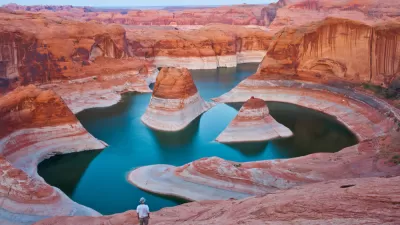Climate change and irrigation schemes are drying up rivers and speeding the spread of deserts, leading to plans to move tens of millions of people.
"[M]illions of Chinese eco-refugees...have been resettled because their home environments [have] degraded to the point where they were no longer fit for human habitation. The government says more than 150 million people will have to be moved. Water shortages exacerbated by over-irrigation and climate change are the main cause.
The problem is most severe in the north-west, where desert sands are swallowing up farmland, homes and towns. The Yellow river is diverted more than 62 miles (100km) to replenish dried-up reservoirs and aquifers in Minqin, where the population has swollen from 860,000 to 2.3 million over the last 60 years, even as water supplies have declined. It is not enough.
The government pays many farmers to cease production and has relocated thousands of others...out of the worst affected areas. The government has given [them] a new home and land, but the desert winds still howl and [the] fields are bordered by sand dunes. Workers in the fields wear masks to protect their faces from the dust storms that whip in from the dunes."

Planetizen Federal Action Tracker
A weekly monitor of how Trump’s orders and actions are impacting planners and planning in America.

Maui's Vacation Rental Debate Turns Ugly
Verbal attacks, misinformation campaigns and fistfights plague a high-stakes debate to convert thousands of vacation rentals into long-term housing.

San Francisco Suspends Traffic Calming Amidst Record Deaths
Citing “a challenging fiscal landscape,” the city will cease the program on the heels of 42 traffic deaths, including 24 pedestrians.

Amtrak Rolls Out New Orleans to Alabama “Mardi Gras” Train
The new service will operate morning and evening departures between Mobile and New Orleans.

The Subversive Car-Free Guide to Trump's Great American Road Trip
Car-free ways to access Chicagoland’s best tourist attractions.

San Antonio and Austin are Fusing Into one Massive Megaregion
The region spanning the two central Texas cities is growing fast, posing challenges for local infrastructure and water supplies.
Urban Design for Planners 1: Software Tools
This six-course series explores essential urban design concepts using open source software and equips planners with the tools they need to participate fully in the urban design process.
Planning for Universal Design
Learn the tools for implementing Universal Design in planning regulations.
Heyer Gruel & Associates PA
JM Goldson LLC
Custer County Colorado
City of Camden Redevelopment Agency
City of Astoria
Transportation Research & Education Center (TREC) at Portland State University
Jefferson Parish Government
Camden Redevelopment Agency
City of Claremont




























